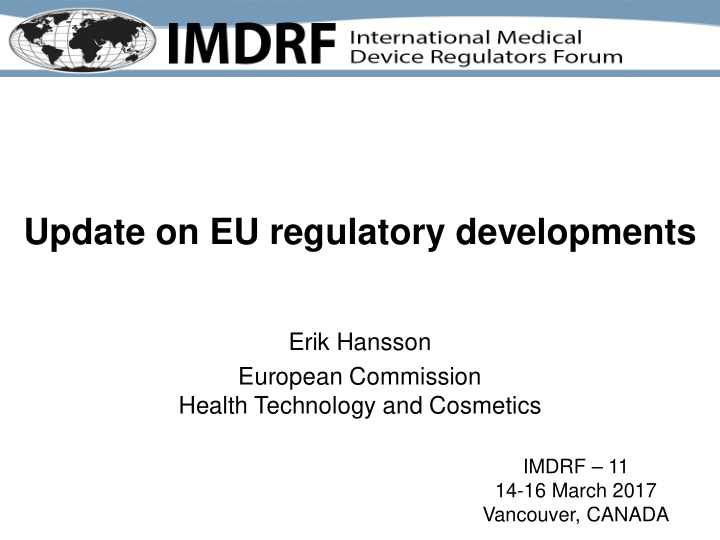



Update on EU regulatory developments Erik Hansson European Commission Health Technology and Cosmetics IMDRF – 11 14-16 March 2017 Vancouver, CANADA
The EU single market for medical devices 1. EU 2. EFTA/ EEA: Norway, Liechtenstein, Iceland 3. Turkey 4. Switzerland 2
Revision of the EU Medical Devices Legislation -Background- Directive 90/385/EEC on active implantable medical devices Directive 93/42/EEC on medical devices Proposal for a Regulation on medical devices Directive 98/79/EC on in vitro diagnostic medical devices Proposal for a Regulation on in vitro diagnostic 3 medical devices
The new regulatory framework in the field of medical devices is expected to ensure... 1. Better protection of public health and patient safety 2. Legal certainty and innovation-friendly environment 3. More transparency and patient empowerment 4. Better coordination at the EU level 4
Main features of the new texts (1) • Stricter pre-market control of high-risk devices with the involvement of a pool of experts at EU level. • Reinforcement of the criteria for designation and of the oversight processes of notified bodies in charge of certifying medical devices. • Coverage of certain non-medical products (mainly aesthetics) which present the same characteristics and risk profile as analogous medical devices. • Introduction of a new risk classification system for in-vitro diagnostic medical devices based on international guidance. • Improved transparency through the establishment of a comprehensive EU database on medical devices. • Stricter regime related to the use of hazardous substances 5
Main features of the new texts (2) • Introduction of an EU-wide requirement for an “implant card” to be provided to patients containing information about implanted medical devices. • Reinforcement of the rules on clinical investigation, including an EU-wide coordinated procedure for the authorisation of clinical investigation on medical devices taking place in more than one Member State. • Reinforced requirements for manufacturers to collect and analyse data about the real-life use of their devices. • Improved coordination between Member States in the fields of vigilance and market surveillance. • The introduction of a UDI (Unique Device Identification) system and strengthening of the device traceability system. • Role and responsibilities of economic operators. Certain new obligations for authorised representatives. 6
State of play and next steps • 26 September 2012: adoption of the two Commission proposals on medical devices and IVDs • 15 June 2016: Council and Parliament reached agreement on the final text • Spring 2017 (expected): Adoption • To be progressively applied over the 3 years (Medical Devices) and 5 years (IVDs) thereafter 7
Towards implementation Tow ards im plem entation 8
Transition period 10- Spring- Spring- Spring- 2016 2017 2020 2022 Final adoption, publication of Full application Full application Regulations in of MDR at 3 of IVDR at 5 Official Journal years (after years (after of European entry into entry into force) Union, entry force) into force 9
Implementation: Commission priorities Notified Bodies (details of application, fees and reimbursements related to JAs) – 6 months Governance: Setting up of the Medical Device Coordination Group (MDCG)* - 6 months Common specification on devices without a medical purpose and Priorities reprocessing of single-use devices – date of application MDR (3 years) EUDAMED – date of application (3/5 years) *The MDCG is the main body supporting the Commission in implementing the future Regulations. It comprises representatives from National Authorities and is chaired by the Commission 10
Thank you for your attention ! Erik Hansson European Commission Health Technology and Cosmetics 11
Recommend
More recommend